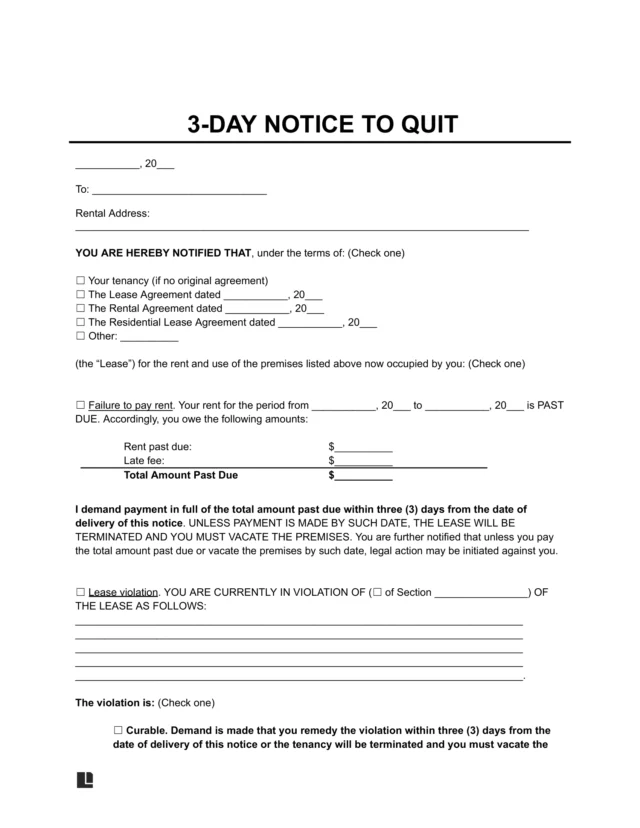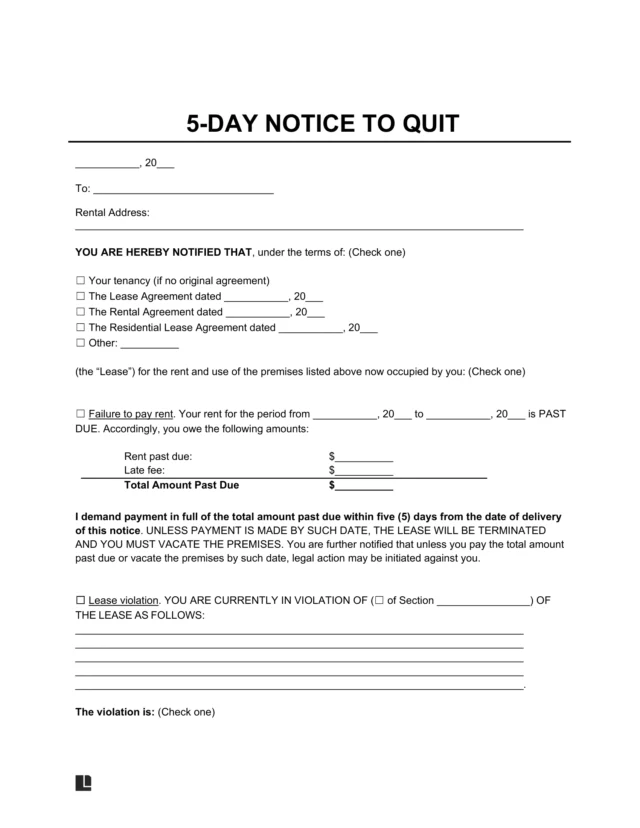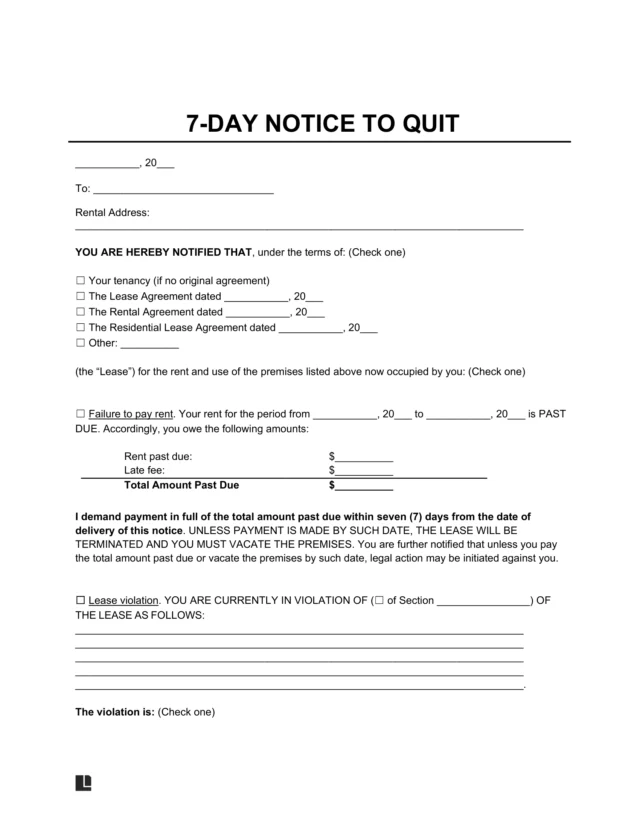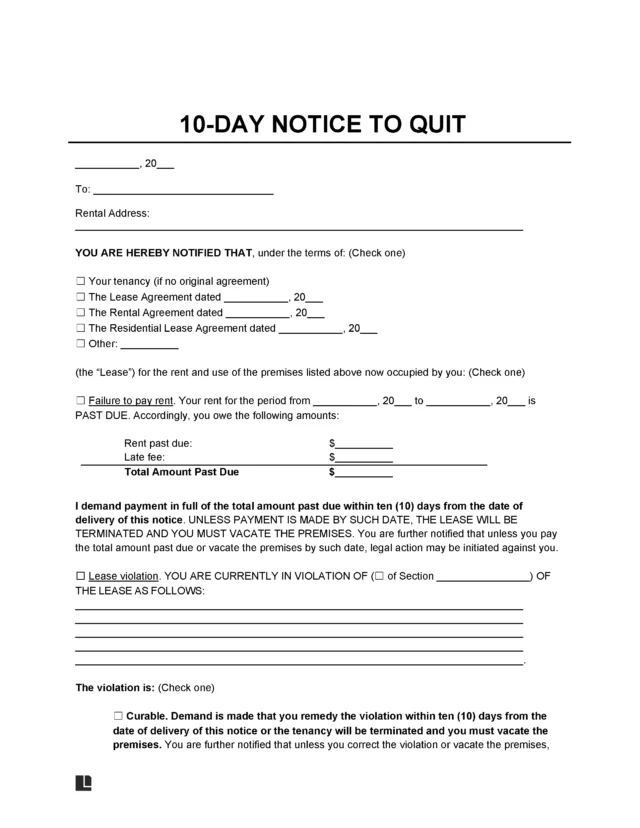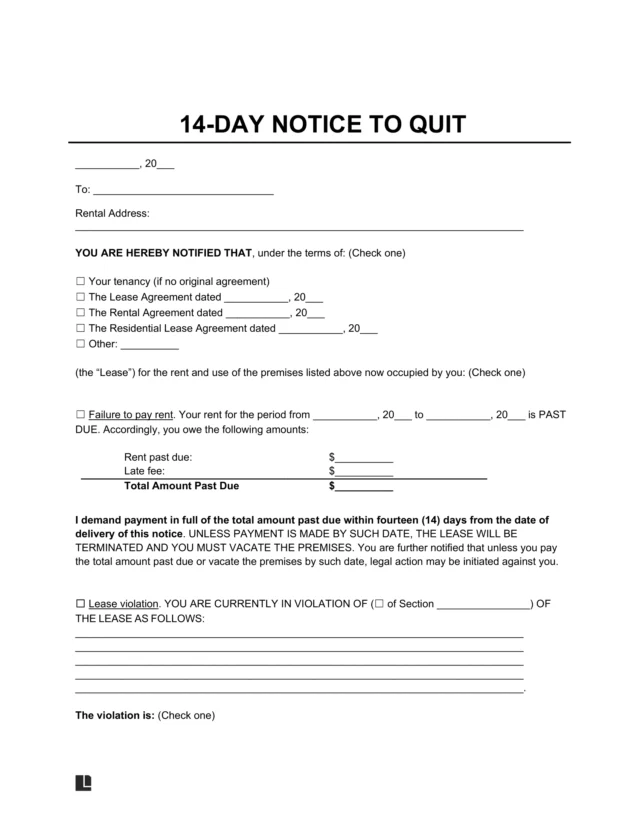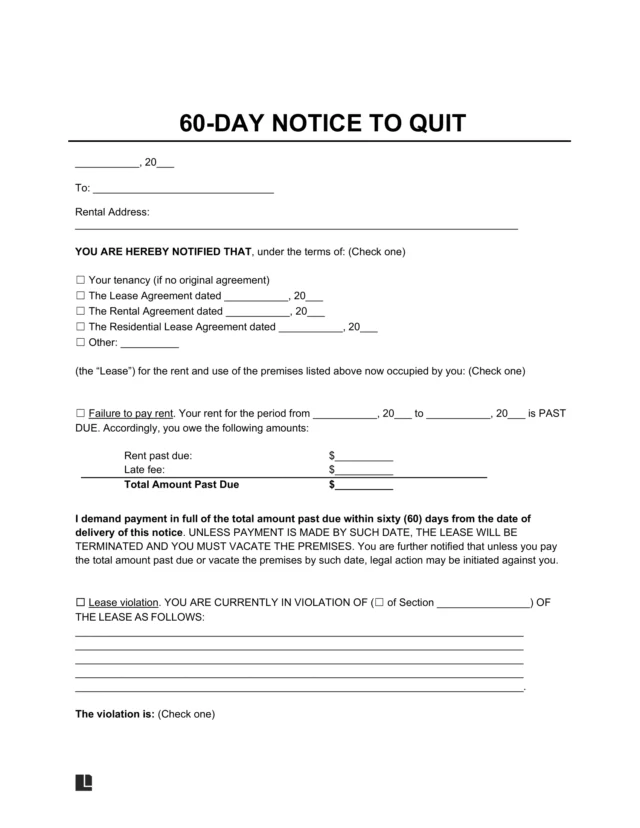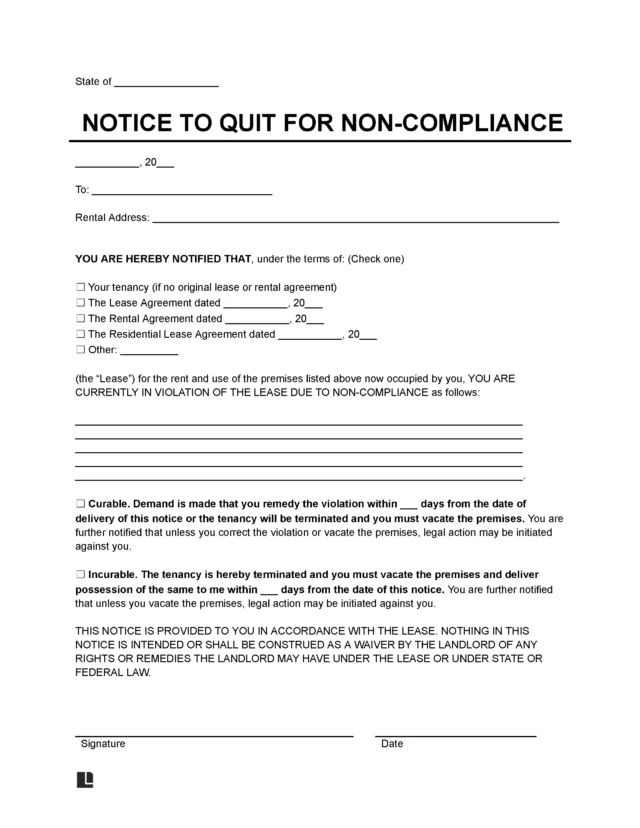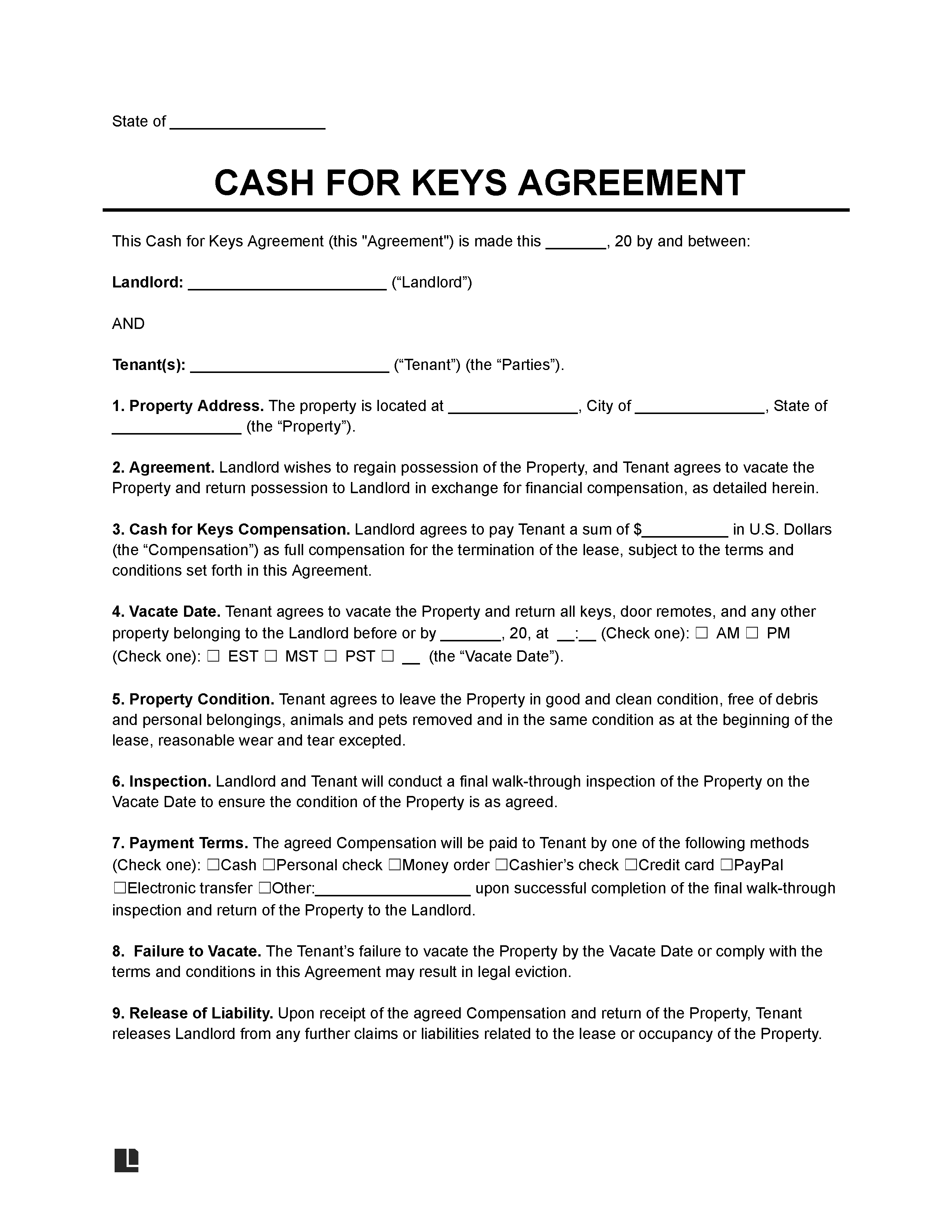What Is a Cash-for-Keys Agreement?
A cash-for-keys agreement is a contract in which the landlord agrees to pay the tenant for vacating the property and leaving it in good condition. Many landlords use this method as an alternative to eviction. All states allow the legal use of a cash-for-keys arrangement to handle tenants who violate a lease agreement.
Legal Templates offers a free cash-for-keys agreement template. Use our legally compliant form to remove tenants from your rental property.
A cash-for-keys arrangement is also used for foreclosures or if the landlord wants to move into or sell their rental property.
Why Use a Cash-for-Keys Agreement?
When your tenant fails to pay rent or breaks the lease terms, providing a cash-for-keys offer motivates them to leave without the force and legal proceedings of eviction. This allows you to avoid the fees, effort, and time used in an eviction. Consider a cash-for-keys agreement for a cheap, quick, and voluntary method of removing tenants.
Cash-for-Keys vs. Eviction
A cash-for-keys agreement differs from an eviction in many ways. Compare the following elements of each process to determine which method works for you:
- Court proceedings: If the tenant doesn’t respond to the eviction notice, the process often involves the courts. A cash-for-keys agreement doesn’t require legal intervention and is only between the landlord and tenant.
- Time required: Negotiating, creating, and enacting a cash-for-keys contract can take only a few days. The eviction process may take weeks or months due to waiting on court orders and meeting the required notice periods.
- Impact on the tenant: An eviction affects the tenant’s rental history and ability to find a new rental agreement. With cash-for-keys, the tenant keeps a clean record and doesn’t have to disclose the agreement on future rental applications.
Pros of a Cash-for-Keys Agreement
A cash-for-keys agreement has many advantages for both the landlord and tenant involved. Consider the following pros of using this agreement:
- It’s faster than pursuing an eviction
- It can preserve both the tenant’s and the landlord’s reputation
- The landlord can replace the tenant with a more responsible renter
Cons of a Cash-for-Keys Agreement
Providing cash-for-keys as an option also comes with risks and disadvantages. Weigh the cons of this agreement, such as:
- Upfront costs of paying the tenant
- Chances of tenant non-compliance
- Risk of property damage from the tenant
How to Write a Cash-for-Keys Agreement
Writing a cash-for-keys agreement requires you to negotiate and explain the terms for the tenant. Clarifying and documenting your agreement ensures everyone is on the same page. Create an effective contract with the following steps:
- Name the parties involved: Provide the landlord and tenant’s full legal names as shown on the lease agreement. Note how many tenants this agreement will affect and the names of each party.
- Provide property information: Record any relevant information about the property being affected. Include the full address of the rental property.
- Determine the payment details: Communicate with the tenant to negotiate the amount and the payment method. Evaluate the rental market and property condition to reach an appropriate amount.
- Set the move-out date: Establish your tenant’s move-out deadline. Include the agreed-upon date and time for them to vacate the property.
- Add extra provisions: Consider other terms, such as how to handle security deposits, overdue rent, or unpaid utility bills. Include terms requiring the tenant to leave the unit in good condition, clean, and free from any damage.
- Select the governing state: Typically, the agreement is governed by the state where the property is located. Any disputes or legal claims are handled according to state laws and courts.
- Sign and date: Both parties should sign and date the agreement to signify their understanding of the terms. This also ensures each party is responsible for upholding their end of the deal.
Sample Cash-for-Keys Agreement
See our free cash-for-keys agreement sample below for the proper formatting and terms. With our customizable form, you can easily add the conditions that work for you and your tenant and then download in PDF or Word format.
Tips for the Cash-for-Keys Process
When done well, a cash-for-keys agreement can benefit everyone involved. Consider using these tips to create an effective cash-for-keys arrangement.
Avoid Self-Help Evictions
A self-help eviction is an attempt by a landlord to remove tenants without the proper legal processes. This can include removing tenant belongings, canceling essential utilities, or changing the locks. Almost all states have laws against self-help evictions, and landlords may face fines or legal consequences. If you need to remove someone from your property, avoid self-help evictions and opt for an alternative, such as cash-for-keys.
Consider the Security Deposit
Remember that the security deposit you collected at the beginning of the lease term is separate from the amount paid in a cash-for-keys deal. Outline the method for returning a security deposit depending on the property’s condition. Also, follow any security deposit terms in the original lease contract.
Provide the tenant with a move-out inspection checklist detailing how to leave the property and fees for damages beyond normal wear and tear.
Maintain Records
All parties involved should keep a copy of the agreement for their records. Having a written contract ensures everyone is aware of the terms. Outline expectations for property condition, payments, and legal obligations. The document can also serve as proof in case of further legal disputes.
In addition to a copy of the cash-for-keys contract, create a receipt showing the amount and method of payment. Everyone involved should also keep the receipt for tax purposes and legal proof. The IRS considers this sum of money taxable income for the tenant who receives it. Tenants report this income on Form 1099-MISC.
Follow Fair Housing Laws
Landlords must comply with the Fair Housing Act and the Americans with Disabilities Act (ADA) and any other applicable state and federal discrimination laws. Under these laws, landlords cannot discriminate against tenants based on protected characteristics such as race, color, national origin, religion, sex, familial status, or disability, and they must provide reasonable accommodations for individuals with disabilities.
Avoid using a cash-for-keys arrangement to remove tenants based on discrimination against the protected demographics.



